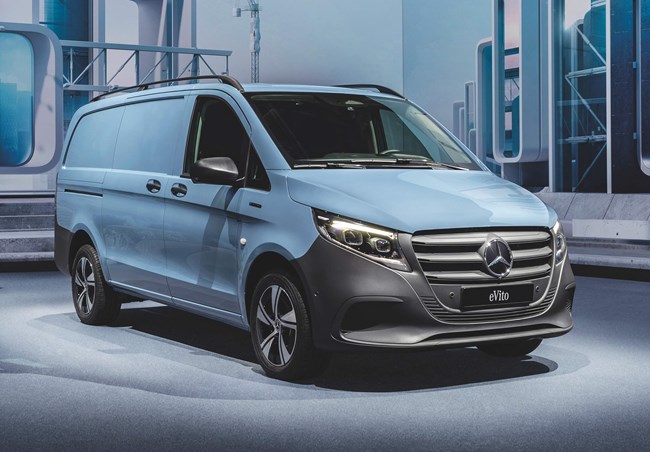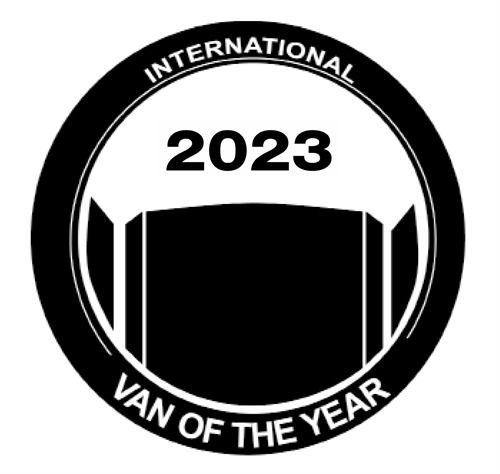- ETRUX launches new Ford E-Transit Trizone
- Renault gives UK debut to Master E-Tech at CV Show
- Isuzu D-Max long-term test – Latest Report
- Isuzu D-Max V-Cross Steel Edition revealed
- IVOTY Report: Stellantis explores the hydrogen proposition
- New Maxus EVs include eDeliver 5 van
- Used LCV values reach six-month high
- ADVERTISEMENT FEATURE: IVECO Daily Mission Awards 2024 Q2 Round-up: Grounds Maintenance & Forestry
- Stellantis Pro One electric vans review
- Mitie adds 5,000th EV to fleet
IVOTY Report: V is for premium
Date: Friday, September 1, 2023 | Author: George Barrow
Mercedes’ new Vito travels further upmarket as it heads towards Net Zero.

Mercedes-Benz has updated its mid-sized vans with a face-lifted front end and interior upgrade in what will likely be the last update for European models of the Vito as we know it.
“We’ve put a significant amount of money to at least update [the Vito] and we’ll make it at least future ready,” explains Klaus Rehkugler, Mercedes-Benz global head of sales and marketing. The new updates will be applied to the Vito and the eVito – which will be launched in 2024 – moving the van even further upmarket with the introduction of more technology and safety systems.
The push upwards for the medium van is also reflected in Mercedes’ revisions to the V-Class luxury people mover and its electric equivalent, the EQV. Like with its passenger car stablemates, Mercedes’ is following a premium strategy with its commercial vehicles to separate them from the competition, while also bridging the gap to the tech-heavy electric vehicles that will be built on the upcoming VAN.EA platform, which will begin in 2025, ultimately delivering both medium and large van variants.
“I think you’re going to have a customer maybe in three or four years down the road that will make a conscious decision – ‘do I run with the existing one, or do I want the brand new [electric] thing on the block?’,” says Rehkugler. The Vito will be available as both a panel van and crew cab, while the Vito Tourer provides an alternative to the increasingly upmarket V-Class.
The new Vito gets an enlarged grille that on higher trim levels will incorporate Mercedes’ Multibeam LED headlights with adaptive main beams. At the rear there’s also a new bumper and redesigned LED lights. The star of the show, however, is inside where the Vito gets the same 10.25in touchscreen and MBUX system destined for the updated eSprinter van. There’s also a full-colour 5.5in trip display for the instrument cluster. The new centre console will have the option of wireless charging for smartphones and keyless start as well as a heated steering wheel. Other changes include new air vents and a new generation of capacitive hands-off recognition steering wheels that will help lead the way for a degree of autonomous driving. Big safety improvements include auto lights and wipers, intelligent speed assist, brake assist with cross-traffic alert, blind-spot warning, active lane assist, speed limit detection and a reversing camera. There will also be additional safety systems with a driving assistance package that includes adaptive cruise control, 360° cameras and active speed limit assist. A parking package also includes park assist, trailer assist and pedestrian alert. Mercedes won’t officially confirm the engines or motors for the updates of the Vito and eVito, but they’re widely expected to be versions of the current powertrains with the electric versions getting the recently updated 66kWh battery that will provide a stop-gap to the incoming VAN.EA architecture.

Speaking at a Mercedes-Benz strategy update outlining its plans through to 2030, Mathias Giesen, head of Mercedes-Benz Vans, said: “We have one shot to do it right and decided to merge all products of the medium and large segments on one architecture – from V-Class up to Sprinter. It gives us scale and reduces complexity. We use this leap of switching to electromobility to simplify the overall portfolio as well.”
If the eVito has a tough job of bridging the gap to the purpose-built electric vehicle of future Mercedes, the task of the Vito with an ICE engine is gargantuan in comparison. Keeping in touch with a world that is constantly looking to replace you is difficult to say the least, and to remain relevant for upwards of a decade sounds improbable for the diesel van.
“We have a purpose-built architecture [VAN.EA] that really carries us into the long-term future, and with this architecture we will definitely go into the sunset – whether that sunset is 2030 or 2035,” Rehkugler says.
Mercedes has already spelled out its path to net zero, and along with the VAN.EA platform, there are several steps to making this automotive giant carbon neutral – not least with sustainability improvements to its production methods and materials – but ICE models will still run concurrently with the future generations of zero-emission vehicles.
Barring any momentous breakthroughs ahead of the launch of VAN.EA models, commercial vehicles will still require a driver and loadspace. The fundamentals of current and new models will therefore remain similar, if not the same. “What has made us successful in the past is not necessarily what will make us successful in the future. I don’t think that the formula for success today necessarily carries you to the same level of success tomorrow. You also have to compromise on certain things that you’re not going to have in tomorrow’s world. You’re going to have some additional features that you don’t have today. I think the future electric product, when you look at 10 features, maybe eight features, are the same.
“But there’s probably two or three additional features that you’re going to have on top, like an electric power take-off, low voltage and high voltage, electric power take-off, so your craftsmen carry 50 tools and just work offline,” he adds.
Details of what the VAN.EA models will look like are unclear but Mercedes talks about their future electric product in the context of both medium and large vans. It is also being billed as a van for multiple markets – that’s despite the updated eSprinter coming next year, getting a big push in the US and Canada, a market the Vito (renamed the Metris) is leaving. Rehkugler explains that the future of the Vito in North America isn’t confirmed, but that VAN.EA will go some ways to filling the gap left by the Metris. That could mean a product that sits slightly below the Vito in size but straddles the same footprint – similar to the VW ID Buzz that gets five-seat and seven-seat variants as well as a panel van. Whatever direction VAN.EA takes the mid-sized Mercedes van range in, Rehkugler is confident both ICE and EV will co-exist together for a while and that customers will adapt to their current electric vehicle price sensitivity. “I’m a strong believer that a three-year residual of a purpose-built electric vehicle will be the same as a three-year residual on an ICE vehicle,” he says.
Electric vans won’t necessarily have such a premium purchase price in the future, but diesel models becoming more expensive is likely. “My hypothesis is that CO2 driving will just become more expensive over time and that’s going to determine the attractiveness of electric,” Rehkugler contends.
Whether it’s through an increase in list price – driven by the R&D costs of further emission regulations becoming tighter – or greater taxation through VEDs or fuel duty, price parity between ICE and EV will eventually align, not necessarily as an up front price, but across the life of the vehicle in shorter time frames than we currently see. The Vito, eVito and V-Class may well be the swansong of the current Mercedes mid-size platform, but their increasing premium aspirations are perhaps a sign of things to come in the pure zero-emission market of future Mercedes-Benz vans.
More luxury for Merc’s passenger vans
More notable than the upgrades to the vans are the changes being made to the V-Class passenger van and its all-electric sibling the EQV as well as the Marco Polo camper van.
If the new touchscreen MBUX system is the main attraction for the vans, then the new statement grille is the highlight of the revamped V-Class. Available in four variants, entry-level V-Class, V-Class Style, Avantgarde and Exclusive, it’s the latter trim that sets the passenger variant of the Vito apart.
Despite there being optional design packages, AMG Line and Night package, the range-topping V-Class Exclusive with its upright grille sets the tone for the luxury direction in which the model is heading.
With monoblock alloy wheels reminiscent of the W124 E-Class from the 1990s, it’s the inclusion of the Mercedes star on the bonnet – for the first time on the V-Class – that really turns heads. The EQV, V-Class and V-Class Marco Polo also have a new chrome trim strip with Mercedes-Benz lettering at the rear as well as another first, two 12.3in widescreen displays. Aside from the eye-watering costs of the optional rear massage seat, there’s really not much to dislike about the upgrades.
Monthly matters more
I’ll admit I’m often focused on the new and shiny products set to be rolled out, while the nitty gritty of what we’re buying now, and how, gets overlooked.
Speaking with Mercedes-Benz global head of sales and marketing, Klaus Rehkugler, having just been shown the next iteration of the Vito-based Marco Polo camper van – a vehicle likely to cost in excess of £90,000 – I asked if the price of such vehicles and EVs was becoming increasingly excessive.
Expecting him to circumvent the question with a trite reply about TCO and residuals, I was delighted with this plain-spoken reply: “We look at MSRP [manufacturer’s suggested retail price] and I think it’s becoming less important.” “People are more into leasing because they have a disposable income on a per month basis,” he argues.
Of course, TCO and RVs will be a factor in that monthly figure, but for those able to reclaim VAT and write-off their interest payments, sticker price is becoming less of a concern. As many current EVs are nearly double their ICE equivalent, surely knowing that a fixed monthly payment is your only liability is the sort of peace of mind buyers crave in times of spiralling costs.
George Barrow is the UK jury member for the International Van of the Year Award. Additional reporting by Liam Campbell.
View The WhatVan Digital Edition


